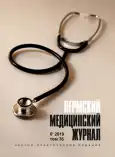Polymeric synthetic materials as basis for biofilm formation by staphylococci
- Authors: Stepanov M.S.1, Kobzarenko E.E.1, Godovalov A.P.1
-
Affiliations:
- E.A. Vagner Perm State Medical University
- Issue: Vol 36, No 6 (2019)
- Pages: 72-75
- Section: Biology and experimental medicine
- URL: https://bakhtiniada.ru/PMJ/article/view/19251
- DOI: https://doi.org/10.17816/pmj36672-75
- ID: 19251
Cite item
Full Text
Abstract
Aim. To study and compare the features of formation of biofilms S. aureus and S. epidermidis on synthetic materials from polyvinylchloride and polystyrene.
Materials and methods. In the experiments, S. aureus and S. epidermidis strains as well as polymeric synthetic materials were used. Expression of biofilm formation of these strains on polystyrene and polyvinylchloride was studied. Biofilm formation was determined in sterile flat-bottomed tablets. Into a part of tablet holes, pieces of polyvinylchloride measuring 5×5×1 mm were placed. They were cultivated at the temperature 37 ºC for 24–48 hours.
Results. On polyvinylchloride, biofilm-forming ability of staphylococci was practically absent. S. aureus is more active in formation of biofilms as compared with S. epidermidis. As incubation period is increased, S. aureus elevates biofilm-forming activity but S. epidermidis does not.
Conclusions. It was established that one and the same microorganisms are different in manifestation of biofilm-forming activity on polystyrene and polyvinylchloride that can be conditioned by various chemical structure of these materials.
Keywords
Full Text
##article.viewOnOriginalSite##About the authors
M. S. Stepanov
E.A. Vagner Perm State Medical University
Email: AGodovalov@gmail.com
Russian Federation, Perm
E. E. Kobzarenko
E.A. Vagner Perm State Medical University
Email: AGodovalov@gmail.com
Russian Federation, Perm
A. P. Godovalov
E.A. Vagner Perm State Medical University
Author for correspondence.
Email: AGodovalov@gmail.com
кандидат медицинских наук, ведущий научный сотрудник ЦНИЛ, доцент кафедры микробиологии и вирусологии
Russian Federation, PermReferences
- Батог К.А., Яковлев М.В., Детков С.В., Годовалов А.П. Аспекты изучения биопленкообразующей активности условно-патогенных микроорганизмов на стоматологических материалах. Современная стоматология: от традиций к инновациям: материалы междунар. науч.-практ. конф. Тверь 2018; 31–34.
- Винник Ю.С., Теплякова О.В., Перьянова О.В., Онзуль Е.В., Козлов В.В. Значение пленкообразующей способности культур стафилококков в выборе дренажного полимера и местных антисептиков при инфицированном панкреонекрозе. Вестник экспериментальной и клинической хирургии 2011; 4 (4): 666–670.
- Николаев Ю.А., Плакунов В.К. Биопленка «город микробов» или аналог мно-гоклеточного организма? Микробиология 2007; 76 (2): 149–163.
- Стафеев А.А., Зиновьев Г.И. Биопленка на границе конструкционный материал – фиксирующий материал – ткань зуба. Институт стоматологии 2012; 2 (55): 76–77.
- O’Toole G.A. Microtiter dish biofilm formation assay. J Vis Exp 2011; 47: 2437.
Supplementary files






